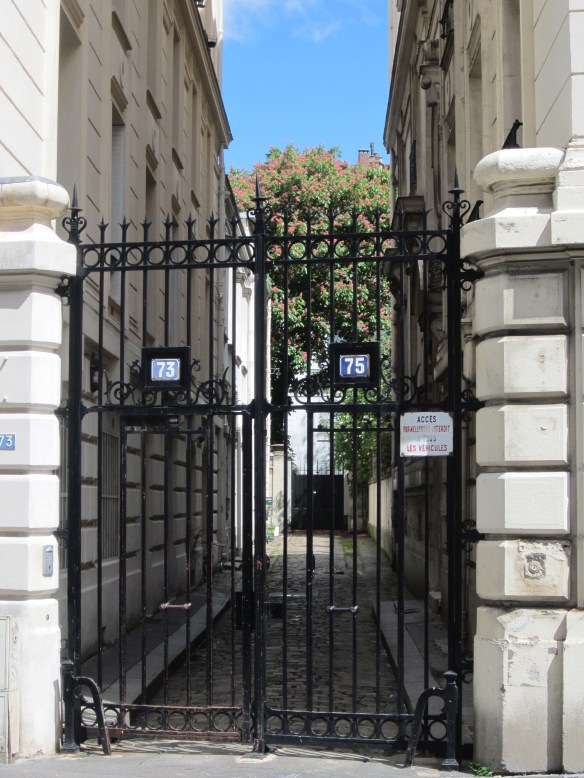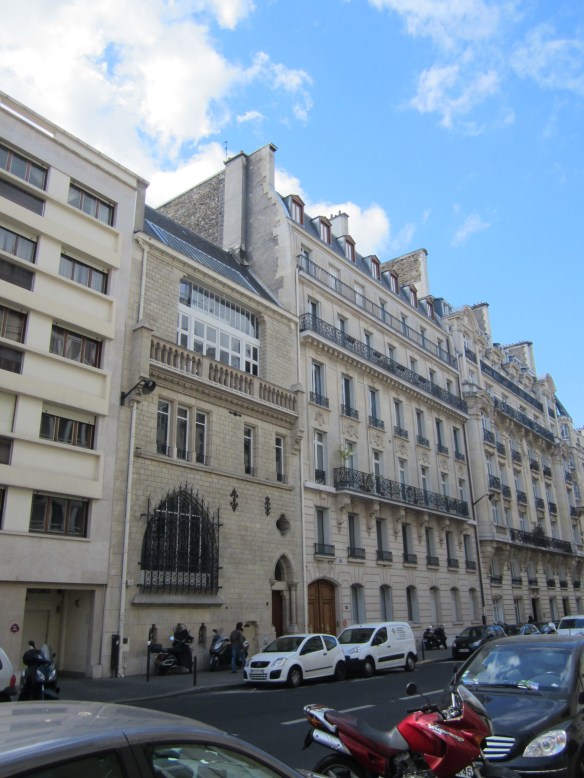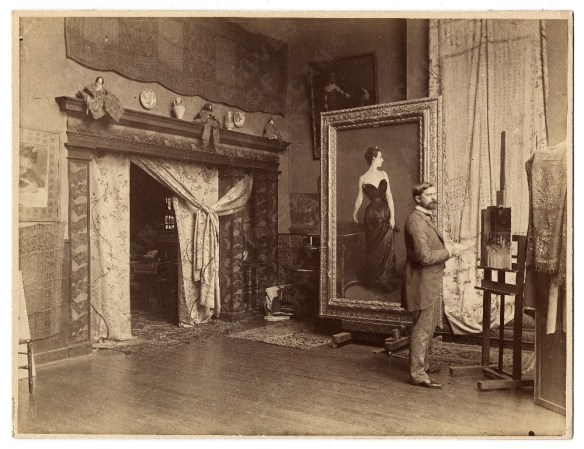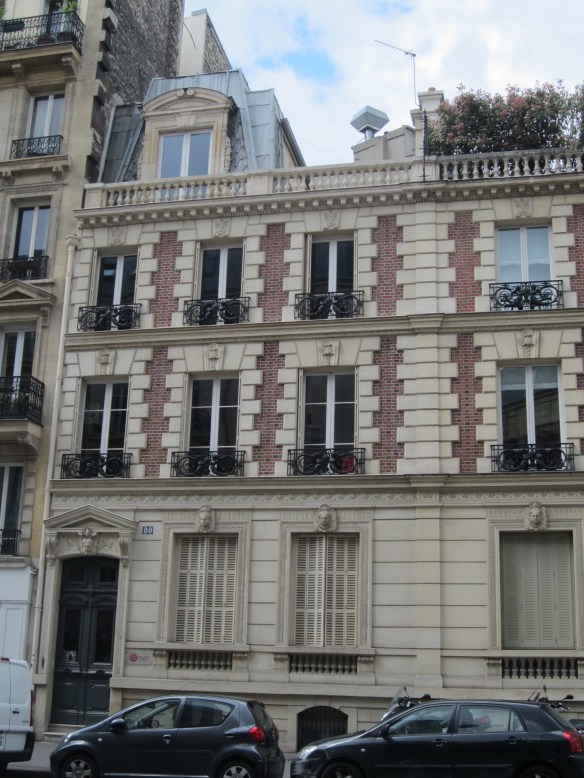I first read Gioia Diliberto’s I Am Madame X back in 2004. I might have even picked it as a book club read. It’s a fabulous Belle Epoque novel about the life and times of the celebrated 19th century American portrait artist John Singer Sargent and his most infamous model, American beauty Virginie Gautreau.
I read it again recently, because John Singer Sargent’s name keeps popping up on my travels through Paris art history. This book is even better the second time around, especially now that I know my way around Paris and I can really appreciate what it meant to be a Left Bank artist versus a Right Bank Artist.
John Singer Sargent had the best of both worlds.
He was the son of a wealthy, cosmopolitan American family that had lived abroad for decades by the time they arrived in Paris in 1874. They settled into a posh Right Bank apartment near the Champs-Élysées, which has since become a commercial building at 52 rue La Boétie. Sargent’s father took him to meet the young teaching master Carolus-Duran, who ran a popular Left Bank painting atelier in the heart of Montparnasse.
Sargent was only 18 years old, but he was already bursting with talent. He quickly earned the admiration of his fellow students and within a year was accepted at the rigorous L’Ecole des Beaux Arts. In 1875, Sargent moved out of the family’s home and into a fifth-floor studio apartment at 73 rue Notre-Dame-des-Champs with fellow art student James Carroll Beckwith.
The young American artists had found a promising location. The studios at 73 rue Notre-Dame-des-Champs had also housed the famous French painter Jean-Paul Laurens, while 75 was the mansion-atelier of Adolphe William Bourguereau. By the 1860s, this small, winding road had already been nicknamed “the royal road of painting.” Even today, the address looks inspiring. It still has an impressive entrance and an inviting green courtyard.
Sargent, Beckwith and their pals led a young bohemian life in the Left Bank. They worked hard but still had time for wild evenings, moving the easels aside for dancing and drinking right in the studio. Sargent was known for entertaining his guests on a rented piano. On Sunday nights, they would clean themselves up for a proper dinner party at Sargent’s family’s home with “educated and agreeable” conversation.

Courtyard of 73-75 rue Notre-Dame-des-Petit-Champs. Back in the 1870s, the gardens probably went all the way through to Luxembourg Gardens
In 1879, Sargent painted the portrait of his art teacher Carolus-Duran, and it absolutely launched his career. It was bold, theatrical, and presented a stunning likeness in both spirit and physicality. Sargent was only 23 years old and already one of the best portrait artists in France.
In Diliberto’s novel, Sargent meets the future Madame X at a Montparnasse restaurant. In reality, they may have met when Gautreau attended an informal party at Sargent’s studio on rue de Notre-Dame-des-Champs in 1881. Sargent was celebrating the completion of his portrait of Dr. Pozzi, one of Gautreau’s many reputed lovers. According to Diliberto, Gautreau was shocked by Sargent’s portrayal of Dr. Pozzi, a charismatic ladies man (and gynecologist) who had ungraciously tossed her aside before her marriage to Pierre Gautreau:
On an easel near the French doors stood Sargent’s painting of Dr. Pozzi. It looked like a portrait of the devil. Virtually the entire canvas was red – the sumptuous curtains in the background, the carpeted floor. The doctor himself was dressed in red slippers and the red wool dressing gown that I had seen him wear dozens of times. His pose was hypertheatrical; his face was caught in an intense observance of an object outside the canvas, and his elongated fingers tugged nervously at his collar and the drawstring of his robe. His fingers were as sharp as pincers and seemed spotted with blood. Had Pozzi just performed a gynecological operation? Deflowered a virgin?
I just love how Diliberto gave Gautreau such a blunt and penetrating voice. She is clearly no innocent about men, or for that matter, about Sargent’s ability to portray a model’s true character.
Sargent was determined to get the chance to paint Gautreau’s portrait. He obviously understood the PR value of painting the “professional beauty” who was the focus of such much attention and gossip in the affluent social circles of Paris. Gautreau thought about giving her business to other more traditional French portrait artists, but she may have felt a special connection to Sargent. They were both up-and-coming Americans with something to prove to the French.
In the meantime, steady commissions enabled Sargent to buy a large, new home and studio on the Right Bank, closer to all of his wealthy patrons. In the winter of 1883-84, Sargent moved to 41 boulevard Berthier, on the shaded side of a wide street whose light made it a popular location for art studios. It wasn’t far from the new mansions near Parc Monceau, and in fact just a few blocks from Madame Gautreau who lived at 80 rue Jouffroy d’Abbans.
In The Greater Journey, David McCullough describes Sargent’s new Right Bank studio:
. . . a workplace elegantly furnished with comfortably upholstered chairs, Persian rugs, and drapery befitting his new professional standing, and with an upright piano against one wall, . . .
No longer would Sargent’s patrons have to track through the mud and past the questionable bohemians on rue Notre-Dame-des-Champs.

41 boulevard Berthier has been replaced by a newer building, but this one next door is a good example of the types of buildings that once dominated the street, with large windows and skylights on the top floors. It was on this street that Virginie Gautreau would have gone to pose for her portrait.

Parc Monceau in the 17th, the center of the fashionable new Plaine Monceau area of the 1870s-80s. Monet painted this park several times.
By 1883, Gautreau finally agreed to pose for Sargent. He talked her into wearing a black dress that would highlight her unusual color, which included rouged ears, white pastey skin (thanks to lavender skin cream) and brightly hennaed hair. At the end of the day, Sargent may have painted her color a little too well. He captured her true character, just like he had with Dr. Pozzi. Her pose was so confident it seemed haughty.

But the strap was the last straw. The painting we know now, as it appears at the Metropolitan Museum in New York, was retouched. The original painting looked like this – a little risqué, no doubt, but more balanced and much more interesting.
Nevertheless, it was a disaster at the 1884 salon. “Quelle horreur!” said polite Paris society. One critic said the flesh “more resembles the flesh of a dead than a living body.”
Sargent soon left for the summer in London while Gautreau disappeared to Brittany, far from the judgment of Paris. Sargent would keep his Paris studio on boulevard Berthier for two more years, where he proudly displayed Madame X.
Although Sargent may have misjudged the limits of Right Bank tolerance and underestimated their hypocrisy (after all, many of the traditional paintings in the Salon were nudes, and they’re complaining about a little strap?), he would later say that Madame X was “the best thing I have done.”

John Singer Sargent in his boulevard Berthier studio with a retouched Madame X. The strap is repainted.
If your read I am Madame X you will find out much more about Virginie Gautreau: her New Oreans background, her family’s escape to Paris during the Civil War, her early years in a Paris convent school. It’s a well-told story in the voice of a fascinating woman.
I am Madame X by Gioia Diliberto: HIghly recommended.






You must be logged in to post a comment.